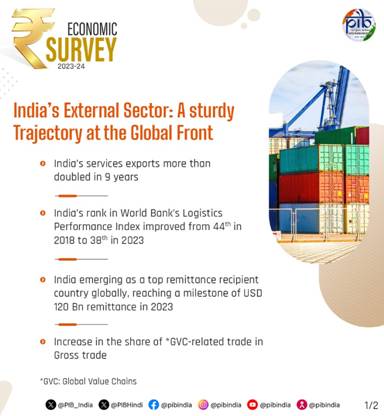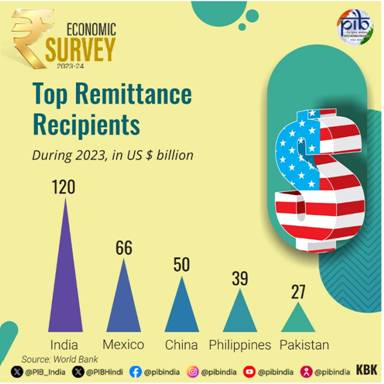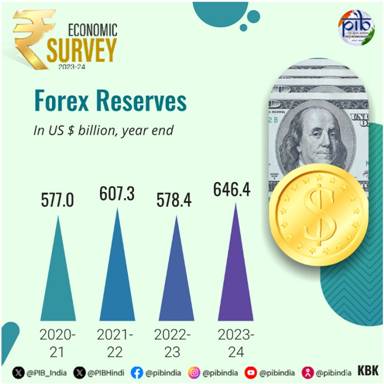Ministry of Finance
INDIA’S EXTERNAL SECTOR SHOWS RESILIENCE AMIDST GEOPOLITICAL HEADWINDS
OVERALL TRADE DEFICIT REDUCES TO USD 78.1 BILLION IN FY24 FROM USD 121.6 BILLION IN FY23
INDIA BECOMES THE SEVENTH-LARGEST SERVICES EXPORTING COUNTRY GLOBALLY
INDIA RANKS 2ND IN THE WORLD IN TELECOMMUNICATION, COMPUTER, AND INFORMATION SERVICES EXPORTS
INDIA’S SHARE OF GLOBAL VALUE CHAINS - RELATED TRADE IN GROSS TRADE RISES TO 40.3 PER CENT IN 2022 FROM 35.1 PER CENT IN 2019
INDIA’S LOGISTICS PERFORMANCE INDEX IMPROVES
INDIA’S CURRENT ACCOUNT DEFICIT (CAD) IMPROVES DUE TO MODERATION IN MERCHANDISE IMPORTS AND RISING SERVICES EXPORTS
REMITTANCES REACH A MILESTONE OF USD 120 BILLION IN 2023
REMITTANCES TO INDIA PROJECTED TO GROW AT 3.7 PER CENT TO USD 124 BILLION IN 2024
INDIA RECEIVES THE HIGHEST EQUITY INFLOWS AMONG EMERGING MARKET PEERS
NET CAPITAL FLOWS STAND AT USD 86.3 BILLION DURING FY24 AGAINST USD 58.9 BILLION DURING THE PREVIOUS YEAR
INDIA WITNESSES POSITIVE NET FOREIGN PORTFOLIO INVESTMENT (FPI) INFLOWS IN FY24 OF USD 44.1 BILLION.
RUPEE EMERGES AS THE LEAST VOLATILE CURRENCY AMONG ITS EMERGING MARKET PEERS
INDIAN RESIDENTS’ OVERSEAS FINANCIAL ASSETS STAND AT USD 1,028.3 BILLION AS ON MARCH 2024, HIGHER BY USD 109.7 BILLION (11.9 PER CENT) COMPARED TO MARCH 2023
EXTERNAL DEBT TO GDP RATIO DECLINES TO 18.7 PER CENT AT THE END OF MARCH 2024 FROM 19.0 PER CENT AT THE END OF MARCH 2023
प्रविष्टि तिथि:
22 JUL 2024 3:07PM by PIB Delhi
India’s external sector remained strong amidst ongoing geopolitical headwinds with services exports continuing to perform well. The overall trade deficit reduced from USD 121.6 billion in FY23 to USD 78.1 billion in FY24. This is stated in the Economic Survey 2023-24 tabled by the Union Minister for Finance and Corporate Affairs Smt. Nirmala Sitharaman in the Parliament today.

SERVICES TRADE
The Economic Survey highlights that the share of India’s services exports in world services exports has risen remarkably from 0.5 per cent in 1993 to 4.3 per cent in 2022. India is now the seventh-largest services exporting country globally rising phenomenally from its 24th position in 2001.
Amongst services exports, software/IT services and business services exports have increased. This was supported by India emerging as a hub for Global Capability Centres (GCCs). India ranks 2nd in the world in telecommunication, computer, and information services exports, 6th in personal, cultural and recreational services exports and 8th in other business services exports.
The growth in Global Capability Centres (GCCs) is reflected in the services BoP, with ‘Other Business Services’ being the second-largest contributor in services exports in FY24 with a share of 26%. In 2012, about 760 GCCs were operating out of India and as of March 2023, India houses over 1,600 GCCs.
MERCHANDISE TRADE
India performed well in merchandise trade despite lowering in global demand with exports crossing USD 776 billion and imports reaching USD 898 billion in FY23. With this, merchandise trade deficit narrowed to USD 238.3 billion in FY24 compared to USD 264.9 billion in the previous year.
There was a slowdown in India’s major exporting partners (especially the EU, whose real GDP grew barely by 0.6 per cent in 2023, compared to 3.6 per cent growth in 2024), along with the lagged impact of monetary tightening carried out by many countries to control rising inflation.
The Survey notes that adverse trade environment in 2023 is expected to ease somewhat this year and next, boosting goods trade in 2024 and 2025. World merchandise trade volume is expected to grow at 2.6 per cent and 3.3 per cent in 2024 and 2025, respectively, as demand for traded goods rebounds.
India’s exports of engineering goods, electronic goods and drugs & pharmaceuticals increased in FY24 on a YoY basis. India’s share in world electronics exports also improved. India maintained a strong foothold in the drugs and pharmaceuticals sector.
Despite high domestic demand due to the relatively strong growth of India’s economy, merchandise imports contracted by 5.7 per cent in FY24, from USD 716 billion in FY23 to USD 675.4 billion in FY24. Imports of capital goods saw an increase, which is welcome as it indicates a heightened demand for machinery, equipment, and other durable goods used in production processes, suggesting potential investments in industrial infrastructure or technological upgrades. A marginal uptick in the share of consumer goods in merchandise imports reflects a stable but limited increase in the importation of finished products for direct consumption.
A targeted focus and a series of measures undertaken by the Government has shown robust growth in product-specific exports in sectors such as – Defence, Toys, Footwear and Smartphones. The share of electronics goods in merchandise exports of India rose from 2.7 per cent in FY19 to 6.7 per cent in FY24, taking India from 28th position in 2018 to 24th in 2022 in global electronics exports.
MEASURES TO EXPAND EXPORTS
The Government has undertaken various measures to promote exports and reduce logistics costs involved in international trade which include setting export targets and their monitoring, provision of export credit insurance services and encouraging banks to provide affordable and adequate export credit to micro, small and medium enterprises (MSME) exporters, enabling them to explore new markets and diversify their existing products competitively.
To boost efficiency and lower logistics costs, the Government launched the PM GatiShakti National Master Plan and the National Logistics Policy (NLP) in October 2021 and September 2022, respectively. Digital reforms, such as the Unified Logistics Interface Platform (ULIP) and the Logistics Data Bank, are additional measures taken towards improving logistics.
Initiatives, such as railway track electrification, reduced release times by the Land Ports Authority of India (LPAI), and the launch of NLP Marine for port-related logistics were also undertaken. Since the launch of the NLP, over 614 industry players have registered on ULIP, 106 private companies have signed Non-Disclosure Agreements (NDAs), 142 companies have submitted 382 use cases to be hosted on ULIP and 57 applications have been made live as of September 2023.
The Survey notes that India stands for an open, inclusive, predictable, non-discriminatory, and mutually beneficial international trade as it can provide an impetus to economic growth. India advocates for a rule-based international trading system with these attributes with WTO at its core. In this spirit, India considers Free Trade Agreements (FTAs) an instrument of trade liberalisation and a complement to the multilateral trading system under WTO. Accordingly, the country is engaged with all its trading partners/blocs to expand its export markets while ensuring better terms for essential imports to meet domestic demand in a cost competitive manner.
The Economic Survey highlighted that India is moving up the global value chains (GVCs), with the share of GVC-related trade in gross trade rising to 40.3 per cent in 2022 from 35.1 per cent in 2019. The improvement in GVC participation is also reflected in increased pure backward GVC participation.
The Survey added that India’s GVC participation has begun to rev up again on the back of incentives provided through schemes such as the PLI and Districts as Exports Hub (DEH) initiative, after the lull seen in the years succeeding the global financial crisis. Survey says that the evidence of India’s enhanced global supply chain participation is reflected in increased investment by foreign firms in electronics, apparel and toys, automobiles and components, capital goods and semiconductor manufacturing in India.
CURRENT ACCOUNT BALANCE
The Economic Survey highlighted that India’s Current Account Deficit (CAD) narrowed to USD 23.2 billion (0.7 per cent of GDP) in FY24 from USD 67 billion (2 per cent of GDP) during the previous year due to a decline in merchandise trade deficit, rising net services exports and increasing remittances.
The Net services receipts increased from USD 143.3 billion during FY23 to USD 162.8 billion in FY24, primarily on account of rising exports of software, travel and business services. The remittances by Indians employed overseas, was USD 106.6 billion in FY24, against USD 101.8 billion during the previous year.
Remittances to India are forecasted to grow at 3.7 per cent to USD 124 billion in 2024 and at 4 per cent to reach USD 129 billion in 2025, emphasized the Survey.

CAPITAL ACCOUNT BALANCE
Emphasizing about the stable capital inflows which continue to finance the CAD, the Survey mentioned that during FY24, net capital flows stood at USD 86.3 billion against USD 58.9 billion during the previous year, primarily driven by FPI flows and net inflows of banking capital.
The Survey emphasized that India witnessed positive net foreign portfolio investment (FPI) inflows in FY24 of USD 44.1 billion, supported by strong economic growth, a stable business environment, and increased investor confidence.
Highlighting that India received the highest equity inflows among emerging market peers during FY24, the Survey listed financial services, automobile and auto components, healthcare, and capital goods were the significant sectors attracting equity inflows during FY24.
The Survey noted that the Net FDI inflows to India declined from USD 42.0 billion during FY23 to USD 26.5 billion in FY24 as an impact of decline in global FDI flows. It further added that the gross FDI inflows moderated only by 0.6 per cent from USD 71.4 billion in FY23 to just under USD 71 billion in FY24.
Highlighting that India has a well-established infrastructure to attract FDI in select sectors, i.e., Greenfield projects such as renewables, digital services such as telecommunications, software and hardware, and consultancy services, the Economic Survey suggested that where investment intentions are high, the sectors must be made more accessible for investments. It further added that the focus must remain on improving the ease of doing business across sectors and extend beyond sectors attractive to FDI alone by working out the details across all levels of government – national, state and local - and across regulators.
The Survey listed that educated labour and a skilled workforce coupled with a vibrant R&D culture are important magnets to enhance sustained investor interest, apart from political stability, policy predictability and stability, reasonable duties and taxes, dispute resolution mechanisms and ease of repatriation.
The Survey highlighted that during FY24, India’s Foreign Exchange Reserve (FER) increased by USD 68 billion, the highest increase among major foreign exchange reserves-holding countries.

The Survey notes that the Rupee emerged as the least volatile currency among its emerging market peers and a few advanced economies in FY24. It further stated that Rising FPI inflows kept the Indian Rupee in a manageable range of ₹82 to ₹83.5/USD in FY24.
The Economic Survey says that Indian residents’ overseas financial assets, by end of March 2024, was at USD 1,028.3 billion were higher by USD 109.7 billion or 11.9 per cent compared to the level as of March 2023. The factors attributed were mainly due to a rise in reserve assets, currency and deposits, overseas direct investment, trade credit and advances and loans.
EXTERNAL DEBT
The External debt to GDP ratio declined to 18.7 per cent at the end of March 2024 from 19.0 per cent at the end of March 2023. Survey added that comparing various debt vulnerability indicators of India with peer countries for 2022 indicates that India is in a better position with relatively low levels of total debt as a percentage of Gross National Income (GNI) and short-term external debt as a percentage of total external debt.
The Economy survey noted that India’s trade deficit is expected to decline further as the PLI scheme is expanded and India creates a globally competitive manufacturing base in several product categories. It added that the recently signed FTAs are expected to increase the global market share of the country’s exports. The Survey mentioned that various international agencies and RBI expect the CAD to GDP to moderate to below one per cent for FY24, driven by growing merchandise and services exports and resilient remittances.
The Survey listed the fall in demand from major trading partners, Rise in trade cost, Commodity price volatility, Trade policy changes as some of the major challenges to India’s balance of trade. The Survey suggested that the changing composition of India’s export basket, enhancement in trade-related infrastructure, enhanced quality consciousness and product safety considerations in the private sector and stable policy environment are expected to play a significant role in driving India’s rise as a global supplier of goods and services.
***
NB/AD/VM/SR/AG
(रिलीज़ आईडी: 2034949)
आगंतुक पटल : 20769